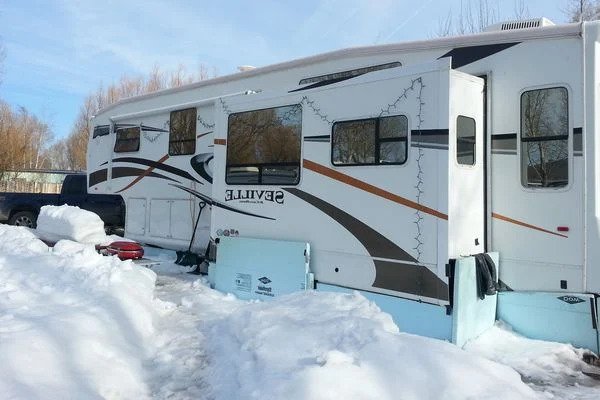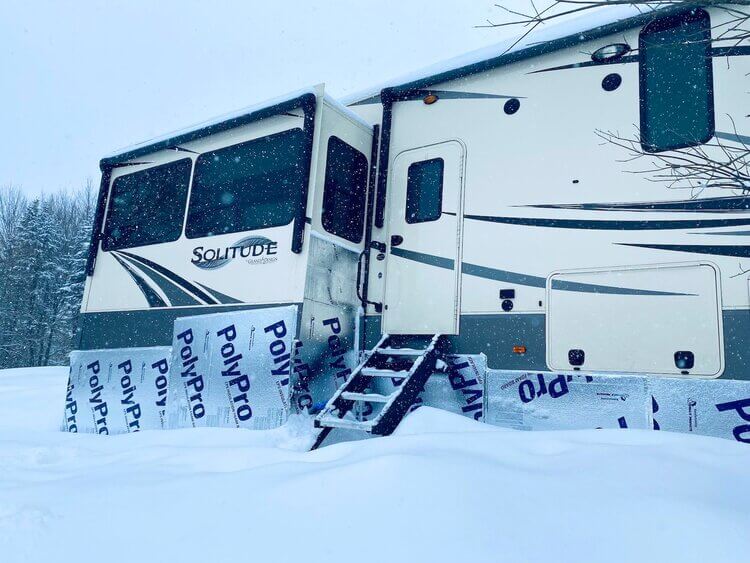Imagine this: you are all packed up and ready to go on your winter camping trip. You climb into your RV, start the engine, and hit the road. A few miles down the highway, you notice that your RV door is starting to freeze shut.
You try to open it, but it’s no use – the door is frozen solid! This can be a major inconvenience (not to mention a safety hazard) when trying to get in or out of your RV. So, what can you do to prevent your RV door from freezing shut? Read on for some tips.
Dealing with a frozen RV door in the dead of winter can be a real pain. Here are a few tips to help keep your RV door from freezing shut and make your camping trip more enjoyable.
Just because the calendar says it’s winter doesn’t mean your RV has to stay cooped up. With a few simple tips, you can enjoy a winter getaway in your RV – even if the door is freezing shut! Keep reading for our best tricks to prevent your RV door from freezing shut this season.
What does it mean RV door freeze shut?

When cold weather sets in, the moisture in the air can condense on surfaces like your RV door. This can cause the door to freeze shut, making it difficult (or even impossible) to open. A frozen RV door is not only a frustrating inconvenience – it can also be a safety hazard.
7 Reasons RV door freezing shut
There are a few reasons why your RV door might freeze shut in cold weather. Here are some of the most common culprits:
Not enough insulation:
If your RV isn’t well-insulated, the cold air can seep in and condense on surfaces like your door. This can cause the door to freeze shut.
Poor ventilation:
Another common cause of a frozen RV door is poor ventilation. If your RV isn’t ventilated properly, the moist air can condense and freeze on surfaces like your door.
Cold weather:
Obviously, cold weather is a major factor in a frozen RV door. If the temperature outside is below freezing, the moisture in the air is more likely to condense and freeze on surfaces like your door.
High humidity:
If the air outside is both cold and humid, the chances of your RV door freezing shut are even higher. The moisture in the air will condense and freeze more easily in high humidity.
When the air is full of moisture (high humidity), it can condense on surfaces like your RV door and cause it to freeze shut.
Not enough heat:
If you’re not providing enough heat inside your RV, the moisture in the air will condense and freeze more easily. This can cause your RV door to freeze shut.
Dirty door:
A dirty door is more likely to freeze shut than a clean one. The dirt and grime can act as a barrier, preventing the door from sealing properly and allowing cold air to seep in.
Leaky door:
If your RV door is not sealing properly, the cold air can seep in and condense on the door. This can cause the door to freeze shut.
Poor seal:
If there’s a gap around your RV door, cold air can get in and cause the door to freeze shut.
Spilled water:
If you spill water on your RV door and it freezes, the door can become stuck shut.
Snow or ice: If snow or ice builds up on your RV door, it can freeze the door shut.
Ways to prevent your RV door from freezing shut

Now that you know some of the reasons why your RV door might freeze shut, let’s talk about how to prevent it. Here are four tips to help keep your RV door from freezing shut this winter:
1. Keep your RV well-insulated
One of the best ways to prevent your RV door from freezing shut is to keep your RV well-insulated. This will help keep the cold air out and the warm air in, making it less likely for the door to freeze shut.
2. Ventilate your RV properly
Another important tip is to ventilate your RV properly. This will help remove the moisture from the air, making it less likely to condense and freeze on surfaces like your door.
3. Keep the temperature inside your RV consistent
One of the biggest mistakes people make is letting the temperature inside their RV fluctuate. This can cause the moisture in the air to condense and freeze, making it more likely for your door to freeze shut.
4. Use a dehumidifier
If you’re using a space heater to keep your RV warm, you might also want to use a dehumidifier. This will help remove the moisture from the air, making it less likely to condense and freeze on surfaces like your door.
5. Keep your RV clean
One of the simplest ways to prevent your RV door from freezing shut is to keep your RV clean. A dirty RV is more likely to have condensation and ice build-up, so it’s important to clean regularly.
6. Seal any gaps around your RV door
If there are any gaps or cracks around your RV door, make sure to seal them. This will help prevent the cold air from seeping in and causing the door to freeze shut.
7. Use a weatherstripping seal
Weatherstripping seals are a great way to help prevent your RV door from freezing shut. These seals create a barrier between the door and the frame, helping to keep the cold air out.
8. Use a door sweep
A door sweep is another great way to help prevent your RV door from freezing shut. These sweeps create a barrier between the door and the ground, helping to keep the cold air out.
9. Keep your RV in a garage or carport
If you have the option, it’s always best to keep your RV in a garage or carport. This will help protect it from the elements and keep it warmer, making it less likely for the door to freeze shut.
10. Use a heated RV mat
If you don’t have the option to keep your RV in a garage or carport, you can use a heated RV mat. These mats plug into an outlet and help keep the ground around your RV warm, making it less likely for the door to freeze shut.
11. Use a space heater
If you don’t have the option to keep your RV in a garage or carport, you can use a space heater. This will help keep your RV warm, making it less likely for the door to freeze shut.
Frozen Door Locks: Solutions
Use a hairdryer: This is the most common solution for a frozen door lock. Simply aim the hairdryer at the keyhole and turn it on high. The heat will melt the ice and allow you to insert your key.
Use a lighter: Another quick fix is to use a lighter. Just hold the flame up to the keyhole for a few seconds to melt the ice. Then you should be able to insert your key and turn the lock.
Use WD-40: If you don’t have a hairdryer or lighter, you can try WD-40. Just spray a little into the keyhole and wait a few minutes. The WD-40 will help to break down the ice and allow you to insert your key.
Petroleum jelly or Vaseline: Another option is to use petroleum jelly or Vaseline. Just apply a small amount to the key before inserting it into the lock. This will help to lubricate the key and allow it to turn more easily.
Soap: A bar of soap can also be used to lubricate a frozen door lock. Simply rub the soap onto the key before inserting it into the lock.
De-icer: You can also buy a commercial de-icer to help thaw out a frozen door lock. Just follow the instructions on the product and apply it to the keyhole.
Heat the key: Another option is to heat up the key before inserting it into the lock. This can be done with a lighter or a hairdryer. Just make sure not to heat the key too much, as it could damage the lock.
Conclusion:
There are a number of ways to prevent your RV door from freezing shut. The best way is to keep your RV clean and free of condensation. You can also seal any gaps around the door, use a weatherstripping seal, or use a door sweep.
If you have the option, it’s always best to keep your RV in a garage or carport. You can also use a heated RV mat, space heater, or de-icer to help prevent the door from freezing shut.
>>Read More:

Hi I’m Joiel Borid Creators of RV Outsider. Wild Life’s first camping was started when I’m 8 years old, at the Home Front Yard. Moto of RV Outsider shares my experience, expertise, and knowledge that I learned, and apprises about my next journey. So stay tuned with RV Outsider.
